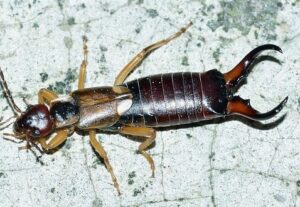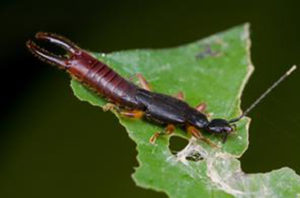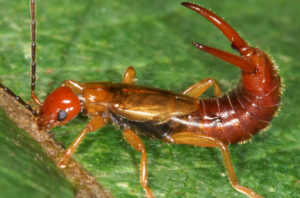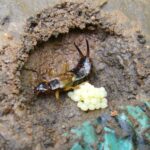There are more than 20 different earwig species making the United States their home.  These fear inducing creatures get their name from the old European myth that they crawl into people’s ears and tunnel into their brains, laying eggs, while the sleeper blissfully dreams on. The nightmare begins the next morning! This superstition has no real scientific basis, but the fear is very real to many people. If you are into horror movies check out the
These fear inducing creatures get their name from the old European myth that they crawl into people’s ears and tunnel into their brains, laying eggs, while the sleeper blissfully dreams on. The nightmare begins the next morning! This superstition has no real scientific basis, but the fear is very real to many people. If you are into horror movies check out the  extremely scary, Night Gallery, TV series episode named “The Caterpillar”. You might want to start wearing earplugs to bed.
extremely scary, Night Gallery, TV series episode named “The Caterpillar”. You might want to start wearing earplugs to bed.
Earwigs are outdoor creatures and can be found living, in large numbers, under lawn debris, mulch or in tree holes. They pose more of a threat to garden plantings than to humans. They spend their days hiding and feeding on leaves, flowers, mold, fungi and plant insects such as aphids. At might they tend to congregate in wet undisturbed areas feeding on decaying plant material. They gain entrance to homes through cracks and crevices and occasionally by wandering in through open doorways as they forage for food. Indoors they can be found near water areas (kitchens, bathrooms, laundry rooms, etc.) and because they are attracted t
numbers, under lawn debris, mulch or in tree holes. They pose more of a threat to garden plantings than to humans. They spend their days hiding and feeding on leaves, flowers, mold, fungi and plant insects such as aphids. At might they tend to congregate in wet undisturbed areas feeding on decaying plant material. They gain entrance to homes through cracks and crevices and occasionally by wandering in through open doorways as they forage for food. Indoors they can be found near water areas (kitchens, bathrooms, laundry rooms, etc.) and because they are attracted t o light, they can be a real problem on porches and patios.
o light, they can be a real problem on porches and patios.
These visually creepy creatures do not spread disease, but they do emit a foul-smelling liquid as a means of self-defense. Their pincers are mainly used to aid in reproduction, hunt prey and for defense. When humans become annoying, they can also use the pincers to pinch. The pinch may be slightly painful but doesn’t transmit venom (since they don’t have any) and rarely breaks the skin.
To get rid of earwigs, you need to get rid of the areas around the home that attract them, such as leaf piles, wood piles, dense vegetation and areas that accumulate moisture. In essence, create a defensive perimeter around your home; move firewood away from the home, cut back dense foliage, and ensure proper drainage away from structures. Its also important to clean downspouts and gutters and make sure they drain away from the home. The key to earwig control is to prevent moisture buildup that attracts them.
Earwigs are easily identified. They have elongated, flattened bodies, usually black to reddish brown in color. They are about ½ inch in length and some species have wings, but rarely fly. Their most distinguishing feature is a pair of large pincers, cerci, at the back end of their body. These forceps-like appendages are what have most people “wigging out”.
The more common earwigs found in California are the European Earwig, Maritime Earwig, and the Ring-legged Earwig.
Fun Facts about Earwigs:
- Lot of earwig species have maternal instincts. They take care of their eggs and tend their young until the young are able to fend for themselves.

- The term earwig is from the old English “eare” meaning ear and “wicga” meaning insect.
- The largest species is found in Australia. It is aptly named the Giant Earwig and is 2 inches long.
Those of you that are known to eavesdrop, you are an “Earwigger”!
**Earwig Nest pictures by: Photo by Tom Oates, 2010(https://creativecommons.org/licenses/by-sa/3.0)]
** Earwig diagram: WikiCommons(https://creativecommons.org/licenses/by-sa/3.0)]
 800-901-1102
800-901-1102
Best view i have ever seen !